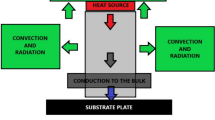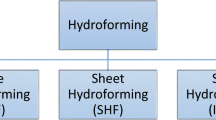Abstract
The aim of this study was to design and fabricate heat sinks with high heat dissipation capacity by using selective laser melting (SLM). A low junction temperature was maintained and the lifetime and reliability of the resultant compact LED recessed downlight (CLDL) was increased. A trapezoidal-finned heat sink with horizontal holes (HFSLM) and three-dimensional metal-foam-like heat sink (3DSLM), which both have large surface-area-to-volume ratios, were designed in this study. Each heat sink was mounted to a 10 W CLDL and installed in a test box with the dimensions 105 mm × 105 mm × 100 mm (L × W × H) for evaluating the lifespan of the CLDL in a high-temperature environment with natural convection. The downlights withstood the test, and according to the Arrhenius equation, they had a long lifetime at normal usage temperatures. The results of the stationary simulations agreed with the experimental results. The temperatures at the solder point of the CLDL with the HFSLM and 3DSLM were 88.6 and 91.4 °C, respectively, corresponding to LED junction temperatures of 118.6 and 121.4 °C. These junction temperatures were lower than the specified LED limit temperature of 135 °C. The results of an accelerated life test prediction and in situ temperature measurement testing based on TM-21 extrapolations using LM-80 data indicated that the lumen maintenance of the CLDLs complied with Energy Star® requirements.














Similar content being viewed by others
Abbreviations
- A.F. :
-
Acceleration Factor is the test time multiplier derived from the Arrhenius equation
- Β :
-
The volumetric thermal expansion coefficient of the fluid
- Cp :
-
The specific heat capacity
- e :
-
Natural logarithms (2.71828)
- Ea :
-
Acceleration energy in electron-volts (eV), thermal activation energy 0.5–0.7 eV for assembly defects
- ε p :
-
The porosity of the porous material
- F :
-
The volume force (body force) in any point of the fluid
- I :
-
The identity matrix
- K :
-
Temperature Kelvin
- k :
-
The thermal conductivity
- κ :
-
The permeability tensor of the porous media
- kb :
-
Boltzmann’s constant (Kb = 8.617 × 10−5 eV/k)
- MCPCB :
-
Metal core printed circuit board
- μ :
-
Dynamic viscosity of air
- p :
-
The pressure
- P total :
-
Total power (W) input to LED (If × Vf, If is LED forward current, Vf is forward Voltage)
- ρ :
-
Density of air
- Q br :
-
A mass source or mass sink, accounts for mass deposit and mass creation within the domains
- R th :
-
Thermal resistance
- R th, b-h :
-
Thermal resistance between MCPCB and aluminum housing
- R th, h-ref :
-
Thermal resistance between aluminum housing and reference point
- R th, hs-box :
-
Thermal resistance between heat sink and test box
- R th, h-hs :
-
Thermal resistance between aluminum housing and heat sink
- R th, j-sp :
-
Thermal resistance between junction and solder point
- R th, sp-b :
-
Thermal resistance between solder point and MCPCB
- R th, sp-ref :
-
Thermal resistance between solder point and reference point
- T :
-
Temperature
- T 0 :
-
The room atmosphere temperature at 25 °C
- T b :
-
MCPCB temperature
- T box :
-
Test box temperature
- T h :
-
Aluminum housing temperature
- T hs :
-
Heat sink temperature
- T j :
-
Junction temperature
- T ref :
-
Reference point temperature
- T room :
-
Room atmosphere temperature (25 °C)
- T sp :
-
Solder point temperature
- T use :
-
Temperature in normal use, in degrees Kelvin (K = °C + 273)
- T test :
-
Temperature in testing, in degrees Kelvin
- u :
-
The velocity vector
- T :
-
The transpose matrix
References
Ahn BL, Park JW, Yoo S, Kim J, Jeong H, Leigh SB, Jang CY (2015) Synergetic effect between lighting efficiency enhancement and building energy reduction using alternative thermal operating system of indoor LED lighting. Energies 8:8736–8748. https://doi.org/10.3390/en8088736
Cai M, Yang D, Tian K, Chen W, Chen X, Zhang P, Fan X, Zhang G (2016) A hybrid prediction method on luminous flux maintenance of high power LED lamps. Appl Ther Eng 95:482–490. https://doi.org/10.1016/j.applthermaleng.2015.11.034
Chein R, Yang H, Tsai TH, Lu C (2010) Experimental study of heat sink performance using copper foams fabricated by electroforming. Microsyst Technol 16:1157–1164. https://doi.org/10.1007/s00542-009-0950-y
Chen Q, Guillemot G, Gandin CA, Bellet M (2016) Finite element modeling of deposition of ceramic material during SLM additive manufacturing. MATEC Web Conf 80:08001. https://doi.org/10.1051/matecconf/20168008001
COMSOL Inc. (2016) COMSOL Multiphysics 5.2a, CFD Module, software licensed by COMSOL Inc. Pitotech, Changhua City
Dreeben TD, Betts D (2014) Simulation and measurement of heat flow in recessed LED fixtures mounted in a UL box. In: Proceedings of the 2014 IEEE intersociety conference on thermal and thermomechanical phenomena in electronic systems (ITherm), Orlando, FL, USA, 27–30 May 2014. https://doi.org/10.1109/ITHERM.2014.6892293
Dutta B, Froes FH (2017) The additive manufacturing (AM) of titanium alloys. Metal Powder Rep 7(2):96–106. https://doi.org/10.1016/j.mprp.2016.12.062
EOS GmbH Electro Optical Systems (2014) Material datasheet: EOS aluminium AlSi10 Mg. https://cdn0.scrvt.com/eos/public/8837de942d78d3b3/4e099c3a857fdddca4be9d59fbb1cd74/EOS_Aluminium_AlSi10Mg_en.pdf. Accessed 20 Dec 2017
Fan J, Yung KC, Pecht M (2012) Lifetime estimation of high-power white LED using degradation-data-driven method. IEEE Trans Device Mater Reliab. https://doi.org/10.1109/TDMR.2012.2190415
Hsu HC, Huang YC (2017) Numerical simulation and experimental validation for the thermal analysis of a compact LED recessed downlight with heat sink design. Appl Sci 7:4. https://doi.org/10.3390/app7010004
Huang WC, Chang KP, Wu PH, Wu CH, Lin CC, Chuang CS, Lin DY, Liu SH, Horng JB, Tsau FH (2016) 3D printing optical engine for controlling material microstructure. Phys Procedia 83(2016):847–853. https://doi.org/10.1016/j.phpro.2016.08.088
Kempen K, Thijs L, Humbeeck JV, Kruth JP (2012) Mechanical properties of AlSi10Mg produced by selective laser melting. Phys Procedia 39:439–446. https://doi.org/10.1016/j.phpro.2012.10.059
Koh S, Yuan C, Sun B, Li B, Fan X, Zhang GQ (2013) Product level accelerated lifetime test for indoor LED luminaires. In: Proceedings of the 14th international conference on thermal, mechanical and multi-physics simulation and experiments in microelectronics and microsystems, EuroSimE 2013, Wroclaw, Poland, 18–20 April 2011. https://doi.org/10.1109/EuroSimE.2013.6529995
Kudsieh N, Khizar M, Raja MYA (2012) Thermal modeling of specialty heat-sinks for low-cost COP packaging of high-power LEDs. In: Proceedings of the 2012 IEEE 9th international conference on high capacity optical networks and enabling technologies (HONET), Istanbul, Turkey, 12–14 December 2012. https://doi.org/10.1109/HONET.2012.6421441
Kushwaha AS, Kirar R (2013) Comparative study of rectangular, trapezoidal and parabolic shaped finned heat sink. IOSR J Mech Civ Eng 5:1–7. https://doi.org/10.9790/1684-0560107
Lampio K, Karvinen R (2017) A new method to optimize natural convection heat sinks. Heat Mass Transf. https://doi.org/10.1007/s00231-017-2106-4
Maaspuro M, Tuominen A (2013) Thermal analysis of LED spot lighting device operating in external natural or forced heat convection. Microelectr Reliab 53:428–434. https://doi.org/10.1016/j.microrel.2012.10.004
Piili H, Happonen A, Väistö T, Venkataramanan V, Partanen J, Salminen A (2015) Cost estimation of laser additive manufacturing of stainless Steel. Phys Procedia 78(2015):388–396. https://doi.org/10.1016/j.phpro.2015.11.053
Qian C, Fan XJ, Fan JJ, Yuan CA (2016) Zhang GQ (2016) An accelerated test method of luminous flux depreciation for LED luminaires and lamps. Reliab Eng Syst Saf 147:84–92. https://doi.org/10.1016/j.ress.2015.11.009
Richman E (2011) Understanding LED Tests IES LM79–LM80–TM21. DOE SSL Workshop. U.S. Department of Energy. http://expertenergy.com.au/documents/Understanding%20LED%20Tests%20IES%20LM79%20-%20LM80%20-%20TM21.pdf. Accessed 18 Feb 2017
Shen Q, Sun D, Xu Y, Jin T, Zhao X, Zhang N, Wu K, Huang Z (2016) Natural convection heat transfer along vertical cylinder heat sinks with longitudinal fins. Int J Ther Sci 100:457–464. https://doi.org/10.1016/j.ijthermalsci.2015.09.007
Thomas DS, Gilbert SW (2014) Costs and cost effectiveness of additive manufacturing, National Institute of Standards and Technology, NIST SP 1176. https://nvlpubs.nist.gov/nistpubs/SpecialPublications/NIST.SP.1176.pdf. Accessed 2 May 2018
Thompson SM, Shamsaei LB, Yadollahi NA (2015) An overview of direct laser deposition for additive manufacturing; part i: transport phenomena, modeling and diagnostics. Addit Manuf 8(2015):36–62. https://doi.org/10.1016/j.addma.2015.07.001
Tong XC (2011) Materials and design for advanced heat spreader and air cooling heat sinks. In: Advanced materials for thermal management of electronic packaging. Springer series in advanced microelectronics, vol 30. Springer, New York, pp 373–420. https://doi.org/10.1007/978-1-4419-7759-5_9
U.S. Department of Energy’s Solid-State Lighting group and the Next Generation Lighting Industry Alliance (NGLIA) (2014) LED luminaire lifetime: recommendations for testing and reporting. https://energy.gov/sites/prod/files/2015/01/f19/led_luminaire_lifetime_guide_sept2014.pdf. Accessed 27 Sep 2016
U.S. Environmental Protection Agency and U.S. Department of Energy (2010) ENERGY STAR® manufacturer’s guide for qualifying solid state lighting luminaires—version 2.1. https://www.energystar.gov/ia/partners/manuf_res/downloads/ENERGYSTAR_Manufacturers_Guide_v2.1.pdf. Accessed 30 Nov 2017
U.S. Environmental Protection Agency and U.S. Department of Energy (2016) ENERGY STAR® program Requirements product specification for luminaires (light fixtures), eligibility criteria version 2.0. https://www.energystar.gov/sites/default/files/asset/document/Luminaires%20V2%200%20Final.pdf. Accessed 27 Sep 2016
West J (2012) The LED lighting facts lumen maintenance metric, a program of the U.S. DOE. D&R International. https://www1.eere.energy.gov/buildings/publications/pdfs/ssl/west_facts_pittsburgh2012.pdf. Accessed 18 Feb 2017
Yang KS, Chung CH, Tu CW, Wong CC, Yang TY (2014) Lee MT (2014) Thermal spreading resistance characteristics of a high power light emitting diode module. Appl Ther Eng 70:361–368. https://doi.org/10.1016/j.applthermaleng.2014.05.028
Ye H, Gielen AWJ, HW vanZeijl, Werkhoven RJ, Zhang GQ (2011) Numerical modeling of thermal performance: Natural convection and radiation of solid state lighting. In Proceedings of the IEEE 12th International Conference on Thermal, Mechanical and Multi-Physics Simulation and Experiments in Microelectronics and Microsystems (EuroSimE), Linz, Austria, 18–20 April 2011. https://doi.org/10.1109/ESIME.2011.5765845
Acknowledgements
The authors would like to acknowledge the support from Laser and Additive Manufacturing Technology Center (LAMC), Industrial Technology Research Institute (ITRI). The authors express their gratitude to Pitotech Co., Ltd., for their technical support. Special thanks is offered to Dr. Forcea Cheng.
Author information
Authors and Affiliations
Corresponding author
Ethics declarations
Conflict of interest
The authors declare no conflict of interest.
Additional information
Publisher's Note
Springer Nature remains neutral with regard to jurisdictional claims in published maps and institutional affiliations.
Rights and permissions
About this article
Cite this article
Huang, YC., Hsu, HC. Numerical simulation and experimental validation of heat sinks fabricated using selective laser melting for use in a compact LED recessed downlight. Microsyst Technol 25, 121–137 (2019). https://doi.org/10.1007/s00542-018-3943-x
Received:
Accepted:
Published:
Issue Date:
DOI: https://doi.org/10.1007/s00542-018-3943-x




